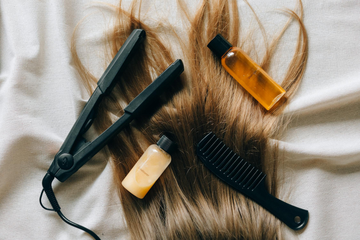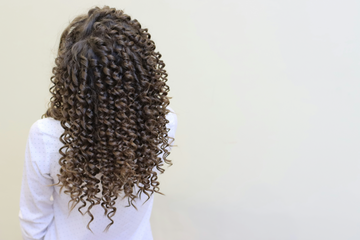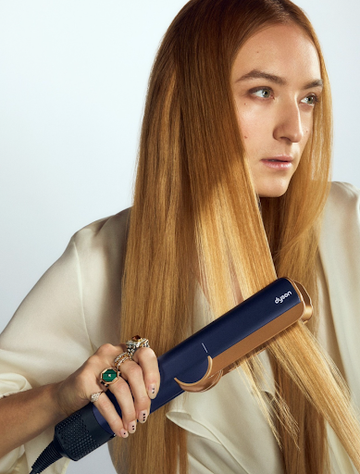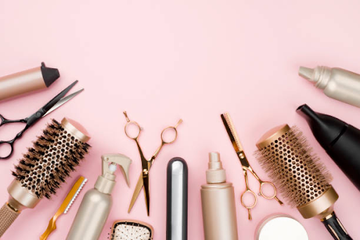TL;DR:
Finding the right flat iron temperature is key to sleek, healthy hair. Fine or damaged strands need 250–300°F, normal hair 300–375°F, and thick hair 375–450°F. Always use heat protectant, work in sections, and start low. The goal: smooth styles without unnecessary damage.
- Fine/damaged hair: 250–300°F
- Medium/normal hair: 300–375°F
- Thick/coarse hair: 375–450°F
- Always apply heat protectant before styling
- Work in small sections for even results
- Start with lower heat and increase only if needed
- Avoid multiple passes—one slow glide is best
- Keep flat iron clean for consistent performance
Hot or not? Hair straightener temperature matters.
Straightening your hair might seem like a no-brainer. Grab the flat iron, turn it up, and bam—you’re ready to go. But temperature matters for healthy, smooth strands.
Cranking up the heat too high? You’re risking fried, frazzled locks. Keeping it too low? Well, say hello to limp, lackluster hair that barely lasts.
Don’t swear off heat styling tools just yet. The perfect heat setting is out there, and it’s the key to straightening your hair without sacrificing its health. Ready to get those straight strands without the stress? That’s what we’re here for.
Best temperatures to straighten hair without damage
Here’s the deal: every head of hair is different. What works wonders on one person’s fine, delicate strands might do major damage to someone with thick, curly hair. The key is to tailor the heat to your hair type.
– Flat iron temperature for fine hair or damaged hair (250°F - 300°F):
If your hair is on the finer side—or you've got color damage or breakage—go easy on the heat. Keep your flat iron between 250°F and 300°F. Trust us, you don’t need anything hotter to get the job done. Too much heat, and you risk snapping those fragile strands right off.
– Hair straightener temperature for normal or medium-textured hair (300°F - 375°F):
Got hair that’s in relatively good shape, with a medium texture? You can step up the heat a little, but don’t go wild. Stick between 300°F and 375°F for a smooth finish without frying your hair’s cuticle.
– Flat iron temperature for thick or coarse hair (375°F - 450°F):
If you’ve got thick, coarse, or natural hair, you need more heat to tame it, but even here, there’s a limit. Keep it below 450°F to avoid going from fabulous to frizz in a flash. Anything over that is basically asking for heat damage, no matter how resilient your hair seems.
Why too much heat is a no-go
Here’s where it gets real. Blasting your hair with heat over 450°F is like turning a blowtorch on your strands.
Sure, it might look sleek at first, but long-term? Expect dullness, breakage, and a whole lot of regret. Your hair’s natural oils and moisture are key to keeping it shiny and smooth—and excessive heat strips all that away.
Finding the sweet spot is essential for maintaining the balance between getting your hair straight and keeping it healthy. Now that you know the right range, it's all about dialing it in.
Your hair deserves better! Here’s how (and what temperature) to flat iron your hair.
Knowing the right temperature is half the battle, but the way you flat iron your hair matters just as much. You wouldn’t crank up the heat on your oven without prepping your food, right? The same goes for your hair. A little bit of prep work and the right technique can save your strands from unnecessary heat damage.
1. Prep like a pro, always using heat protectant
This is non-negotiable! Heat protectant is your hair’s superhero. Without it, your hair is left exposed to the full intensity of your flat iron. A good heat protectant forms a barrier, locking out damage.
Pro tip: Look for a heat protectant that suits your hair type. Opt for lightweight for fine hair or cream-based or oil formulas for thick hair.
2. Work in sections, and don’t rush it
We’ve all been there—you're in a rush, so you grab large chunks of hair and speed through with your flat iron. But this shortcut is doing more harm than good.
When you work in smaller sections, you distribute heat more evenly. This means you won’t have to go over the same spot multiple times. Less passes = less heat exposure = healthier hair. Simple, right?
Take it slow, glide the iron smoothly through each section, and let the tool do the work for you.
3. Start low, go slow
Just because your flat iron can go up to 450°F doesn’t mean you should start there. Begin with a lower setting, especially if you're unsure about your hair’s tolerance. Gradually increase the heat only if needed.
4. The one-and-done rule
The goal is to get the sleekness you want with as few passes as possible. Going over the same section multiple times can weaken your hair and lead to more damage over time. A slow, steady pass at the right temperature will get you that silky finish without frying your strands.
5. Keep your flat iron clean
You might not think about it, but the build-up of product on your flat iron can seriously mess with its performance. A dirty iron means uneven heat distribution, and you’re essentially burning old product into your hair—not cute. Clean your iron regularly with a damp cloth once it’s completely cool.
When in doubt, keep it cool
If you're not sure what heat setting to use, it’s always *safer* to go lower. We’ve all heard the saying, "If you can’t stand the heat, get out of the kitchen." And trust us, the same applies to your hair. We don’t want any burnt strands or fried ends—because that is NOT cute.
Key takeaways to keep in mind:
– Start low. Always begin with the lowest possible heat setting to minimize damage.
– Consider your hair type. Fine hair? Keep it cool. Coily hair? You can handle a bit more heat (between 375°F and 450°F), but never max out the dial.
– Protect, protect, protect. No matter your hair type, always apply a heat protectant to prevent damage.
At the end of the day, straight hair should feel like a dream, NOT a nightmare. Stay mindful of your heat settings and take care of your strands.





